As Planet Drum was forming, printing (which loomed large in San Francisco) seemed the way to keep in touch with activists exploring new social possibilities. Explorations into publishing led to creating a new format. The first publications were called a “Bundle”— not a book, rather individual essays, poetry, graphics and posters, each printed separately and then assembled unbound into an envelope— named PLANET/DRUM. The PLANET/DRUM Bundles were originally conceived to spread planetary information—a “voice for the planet,” and to have production/publishing decentralized, passed around among activists in various locales around the planet, making PLANET/DRUM beats from various places. The first Bundle invited collaboration with, “Do you have a message to send out?”
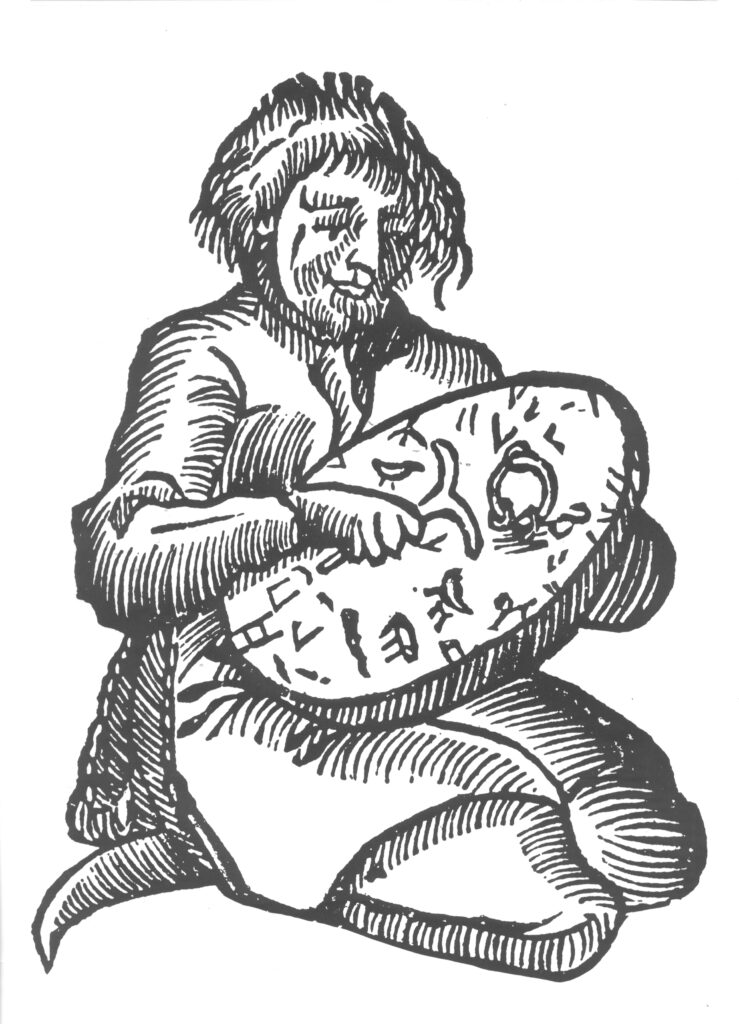
The individual pieces of a Bundle were put into some desired order by whoever opened it. In this way each reader was put in the position of a quasi-editor—somewhat similar to the Sámi shaman in Planet Drum’s logo who is ordering and interpreting symbols adorning the head of his drum.
Ten Bundles were produced by Planet Drum, and two were produced in collaboration with the Bioregional Association of the Americas. Those twelve Bundles were distributed by Planet Drum Foundation. They provided a format that is both useful and expandable. The original Planet Drum Bundles and the pieces within them inspired people to create and produce Bioregional Bundles in Texas, New York and Italy, see below.
Wherever the Bundles were assembled, they became authentic tools for building bioregional awareness. For the people who made the Bundle, it was an in-depth learning experience about their bioregion and/or topics related to it. Bundles were always compiled and produced by or in collaboration with local reinhabitants. Since they were distributed both locally and to Planet Drum’s network, they informed a wide audience of the projects and visions developing in a particular bioregion, and inspired people to form their own bioregional groups and make local Bundles or Bundle pieces.
Planet Drum Bundles
Bundle descriptions & graphics are linked here. Eventually complete texts and graphics for all Bundles may be posted. Contact the office if you’d like more information about the Bundles, and check the Shop for available complete Bundles .
Bundle #1, 1973
Bundle #2, 1974
Bundle #3, 1975, North Pacific Rim Alive
Bundle #4, 1976, Continent Congress
Bundle #5, 1977, Watershed Guide & Living Here
Bundle #6, 1979, Backbone the Rockies
Bundle #7, 1980, Renewable Energy & Bioregions: A new Context for Public
Policy
Bundle #8, 1982, Eco-Decentralist Design
Bundle #9, 1985, Reinhabit the Hudson Estuary 1
Bundle #10, 2004, Tonics for Disinhabitation
Planet Drum Collaborative Bundles
Bundle #11, Bioregional Mapping Bundle, Bioregional Association of the
Northern Americas
Bundle #12, Decision-Making Bundle, Bioregional Association of the Northern
Americas
Planet Drum Inspired Bundles
Bundle #13, Edwards Plateau Bundle, 2016/7(?), produced by Robert F. Young’s graduate
studies Students, U of T Austin,
Bundle #14, Reinhabit the Hudson Estuary 2, 2016 and Reinhabit the Hudson Estuary: A Bioregional Atlas of Places and Peoples, 2018 produced by George Tukel
Bundle #15, Fascicolo #1, 2018, Gruppo di Studio per la Bioregione del Bacino
idrofafico (“Study Group for the Bioregion of the Po River Basin”)
Bundle #16, Fascicolo #2, 2020, TEMA: Testimonianze di resilienza bioregionale
(TOPIC: Testimonies of bioregional resilience)
Bundle #17, Celebrating 50 Years of Living Here, San Francisco Bay Area, 2023,
produced by Artivate Students and Mentors
Bundle #18, Fascicolo #3, 2024, TEMA: “Conoscere la propria bioregione”
(TOPIC: “Knowing your bioregion”)
Bundle #1, 1973
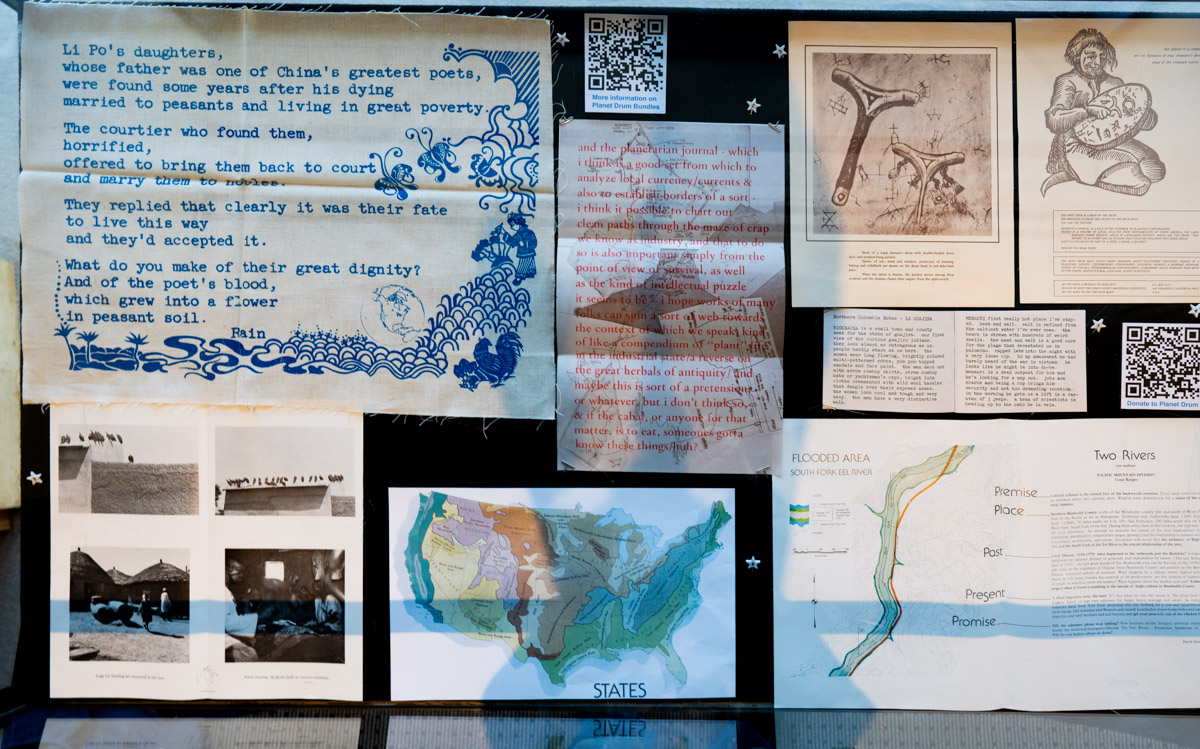
Planet Drum’s first Bundle shares elements that can be mixed and matched, and invites participation in creating the next Bundle. The first Bundle is a beat on a drum. How do you read it? Do you have a message to send out? Are you part of the next beat?
Links below show individual Bundle pieces
- Envelope: plain manila 9.5”x12.5”
- Redwood’s Journal (Northern Columbia Notes) by Redwood. Documents first-hand observations of the lifestyles of Indian people in La Guajira and the Cabo, noting the relationships between characteristics, customs and natural surroundings. 16 page 5”x4” booklet. (green ink on pale green paper)
- A page in the notebook of planeteye explorations by David Empfield. 8.5”x4”
- Sámi Shaman by Ake Gustavsson and explanation of the first Bundle as a beat on the drum. On the reverse is a closeup of the head of the shaman’s drum with a description of how it functions. 8.5”x11″. (Available for purchase within the Shop).
- States is a volume of local analysis from reinhabitants of North America. The land-surface forms suggest areas of land-based identity. Where are you from? On the reverse is Two Rivers, by David Simpson, an entry and outline of the South Fork Eel River that could be followed for other areas. 8.5”x11” four color map poster.
- West Africa Cloth Dying Black and white photographs of the Hausa Tribe of Kano, West Africa by Edmund Shea. 35”x11.5”
- Rain’s Cloth Barbara Lamorticella’s poem silk-screened on a 19”x15” muslin cloth with graphics by Luna Moth Robbin which might be part of a shirt, a shade or a blanket.
Bundle #2, 1974
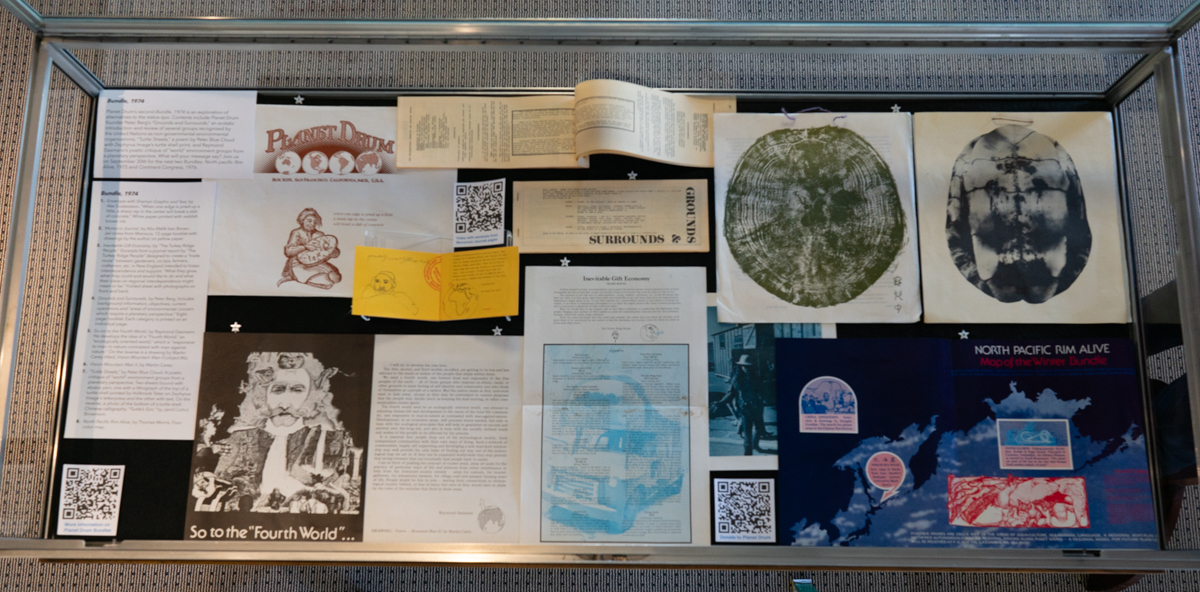
Planet Drum’s second Bundle, 1974 is an exploration of alternatives to the status quo and asks, “What will your message say?”
Links below show individual Bundle pieces
- Envelope: white 11.5”x14” printed with reddish brown ink, Shaman graphic by Ake Gustavsson with Shaman’s text:
“when one edge is pried up a little a sharp rap in the center will break a slab of concrete” - Morocco Journal, Jail notes from Morocco by Abu Malik ben Brown. 12 page 4.5”x4” booklet. (with drawings by the author on yellow paper)
- Inevitable Gift Economy, Excerpts from a journal report by “The Turkey Ridge People” designed to create a “trade route” between gardeners, co-ops, farmers, craftsmen, etc. in New England, to foster interdependence and support. “What they grow, what they could and would like to do, and what their ideas on regional interdependence might mean or be.” 10”x16’ folded sheet with photographs on the front and back. (Available for purchase within the Shop).
- Grounds and Surrounds by Peter Berg, An ecstatic introduction and then review of some groups recognized by the United Nations as non-governmental environmental organizations. Includes background information, objectives, current operations, and “areas of environmental concern which require a planetary perspective.” Groups’ categories are Population Control, Consumers, Environmental issues, Industry, Ethics, and Conservation/Animals. Each category is printed on an individual 11”x4.5” page. Eight page booklet. (Available for purchase within the Shop).
- So on to the Fourth World, by Raymond Dasmann. A poetic critique of “world” environment groups from a planetary perspective. He develops the idea of a “Fourth world,” an “ecologically oriented world” which is “responsive to man-in-nature contrasted with man-against-nature.” On the reverse is a drawing by Martin Carey titled Vision–Mountain Man II. 9.5”x12″. (Available for purchase within the Shop).
- Turtle Sheets, A poem by Peter Blue Cloud. A poetic critique of “world” environment groups from a planetary perspective. Two 11”x12” sheets bound with alpaca yarn, one with a lithograph of the top of a turtle shell printed by Holbrook Teter on Zephyrus Image’s letterpress and the other with text and, on the reverse, a photo of the bottom of a turtle shell. Chinese calligraphy “Turtle’s Son” by Jamil (John) Brownson. (Available for purchase within the Shop).
- North Pacific Rim Alive, Four color Map of the upcoming Winter Bundle designed by Thomas Morris.11.5”x29”. (Available for purchase within the Shop).
Bundle #3, 1975
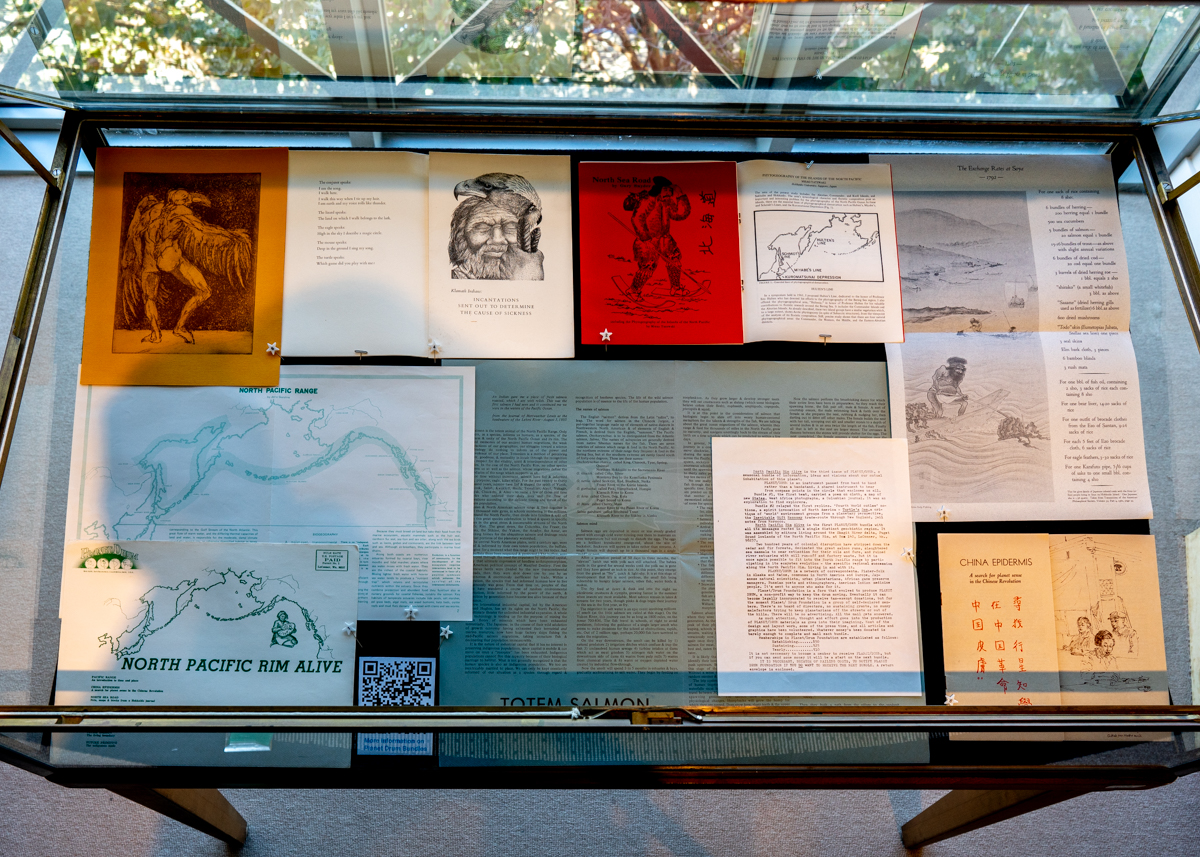
North Pacific Rim Alive
- Envelope: white 9”x12” printed with green ink, graphic is a map of north pacific rim countries with shaman off coast of North America with text North Pacific Rim plus table of contents
- North Sea Road journal booklet by Gary Snyder “Nets, maps, and blocks” from a Hokkaido journal, not previously published. Includes the phytogeography of the islands of the North Pacific by Misao Tatewaki. Maps & layout by Maurie Heald. A 12 page 7”x 8.5” booklet with red cover
- Totem Salmon essay by Linn (Freeman) House which offers an excellent view of our interdependence with another species, presenting salmon as the “totem animal” and living boundary of the North Pacific Rim. House stresses the importance of salmon by presenting an overview of its life cycle and describing its native relationship with tribal people. A single 20”x17” page, printed front and back with woodcut by Phillip McCracken.
- Klamath Indians: Incantations Sent Out to Determine the Cause of Sickness A conjure poem by Carl Cary. Cover has a shaman lithographic by Daniel O. Stolpe. 12”x9.5” folded card.
- China Epidermis An interview conducted in 1973 after Douglas and Marie Gorsline’s return from seven weeks in China. It explores the relations of China’s social system compared to environmental systems and examines the integrative adaptations that reveal its wise commitment to the maximum conservation of materials and energy, decentralized self-sufficiency, urban-rural mix, ethnic diversity, recycling of wastes, low-impact technology, reflexive information flow, and a goal of stable populations. Eight page booklet folded to 8.5”x5” with drawings by Douglas Gorsline.
- Future Primitive A collaboration between Jerry (Jeremiah) Gorsline and Linn (Freeman) House. A call to strive for regional self-sufficiency and the indigenous mode of mind. Culture should be integrated with nature at the level of the particular ecosystem. “Spoken as two voices with images which represent the best cullings from readings in dozens of authors and scholars and from months of discussions with many people on the west coast of North America.” 11”x17” folded card with cover image by Daniel O. Stolpe.
- North Pacific Range by Jerry (Jeremiah) Gorsline. An introduction to the physical base and biogeography of the Pacific Rim as well as its connection to human cultures. 17”x11” poster with a map.
- The Exchange Rates at Soya -1792 A list giving details of Japanese colonial trade with the Ainu (or Ezo) living in Soya on Hokkaido Island. 11”x17” poster with 18th Century drawing of Ainu kelp fishing. Letter press printed at Zepherus Image by Holbrooke Teter.
- Cover Sheet of the North Pacific Rim Alive Bundle which contains an explanation of the concept underlying the bundle publications: “PLANET/DRUM is an instrument passed from hand to hand rather than a bandstand. A shared instrument from compass points to the circle that encloses us all.” It summarizes & describes the first three bundles: Bundle #1 “the first beat”; Bundle #2 “relayed the first replies.” and North Pacific Rim Alive “the first PLANET/DRUM with all its messages rooted in a single distinct geo-biotic region”, and describes PLANET/DRUM as “a network of correspondents. Fisher-folk in Alaska and Maine, communes in North America and Europe, Japanese natural scientists, urban planetarians, African game preserve managers, Russian poets and ethnographers, American Indian medicine people It is sent to anyone who asks for it.” 8.5”x11”. (Available for purchase within the Shop).
Bundle #4, 1976

Continent Congress
- Envelope: white 9”x12” printed with dark blue ink with graphic of Turtle Island Flag designed by Peter Blue Cloud plus tiny shaman. The text is Continent Congress plus table of contents. (Available for purchase within the Shop).
- Amble Toward Continent Congress by Peter Berg, lettering by Franz Cilensek. A bioregional overview of North American history following Columbus’ landing reveals the effect that the ongoing encounter between indigenous peoples and Europeans has had on both cultures, and offers a vision of reinhabitation through bioregionalism. Berg urges “coming together with the continent” in body and spirit because a “region has the power to sustain and join disparate people.” Two-sided, 11″x17″ poster, includes the IUCN’s Biotic Province map of North America with commentary by Raymond Dasmann. Updated and reprinted in 1992 as a “surprise publication” for Planet Drum Members.
- A Winter in the Illinois Woods, excerpts from a journal by Marguerite Swift, about reinhabitation—taking everything back to basics as she spends a winter building and living in a cabin with her husband. 5.5”x8.5” 16 page booklet annotated by James Koller with drawings by Elsa (Skylark) Marley.
- Meat, essay by David Simpson that presents a convincing argument against eating meat, focusing on the enormous strain that our diet and increasingly mechanized mono-agricultural methods place on the earth’s resources. He refers to “the complete subjugation of land, grass, creatures and people to an overblown taste for red meat” and discusses its historical and present-day effects. Four page 5.5”x11” booklet with a cover drawing by Sandy Simonson and a poem by Freewheelin’ Frank Reynolds
- Continent Footing North America, a video conversation with geologist Robert Curry that evokes a sense of the whole of the continent and its parts. He explores the mineral source of life and culture with Peter Berg and Peter Coyote. Graphics from the video made by Peter Berg. 9”x22.5”
- Full Scale Nuclear Social Order 239 Next Question Taboo by Gil Bailie reveals the disastrous effects that full-scale development of nuclear power will have on our biosphere, as well as the cultural and political impacts that will inevitably follow, such as centralization and high technological orientation. Bailie says, “There is nothing on the planet that so completely limits the range of possible choices for future generations as does nuclear power.” 17”x11” folded page with a central drawing by Martin Carey.
- Heterogeneity a poem in the shape of a flower by Allen Van Newkirk exploring the dimensions of ecological consciousness. (Available for purchase within the Shop). Reverse is
- “Passing the Drum” A Table of Contents for the Continent Congress Bundle and an update on Planet/Drum Foundation developments. 7”x10” page folded in half
- New Orleans Report, Committee of Correspondence, “Galvez” Tristes Semi-tropiques by D. Eric Bookhardt, Stephen Duplantier, Chester Kasnowski, Ray Kern This geopsychic study examines the forces involved in regional self-definition. A model for the positioning of regions that sheds light on the lives of places. The Mini-Bundle includes:
- Tractatus Geopsychorum by D. Eric Bookhardt with photographs by Bookhardt, Drury and Bellocq. 18”x22.5” poster with photos
- A Logic of Regions by Stephen Duplantier plays with the idea of imaginatively “terraforming” a sinking and shrinking Louisiana. A region already visibly on the wane because of the rising waters due to marshland erosion of the coast. 11”x17” 4-page essay booklet
- Possible Sound Frequency Map of words used in Louisiana Delta, Providing a Non Border to the Area by Chester Kasnowski 7”x7.5” two-sided card
Bundle #5, 1977
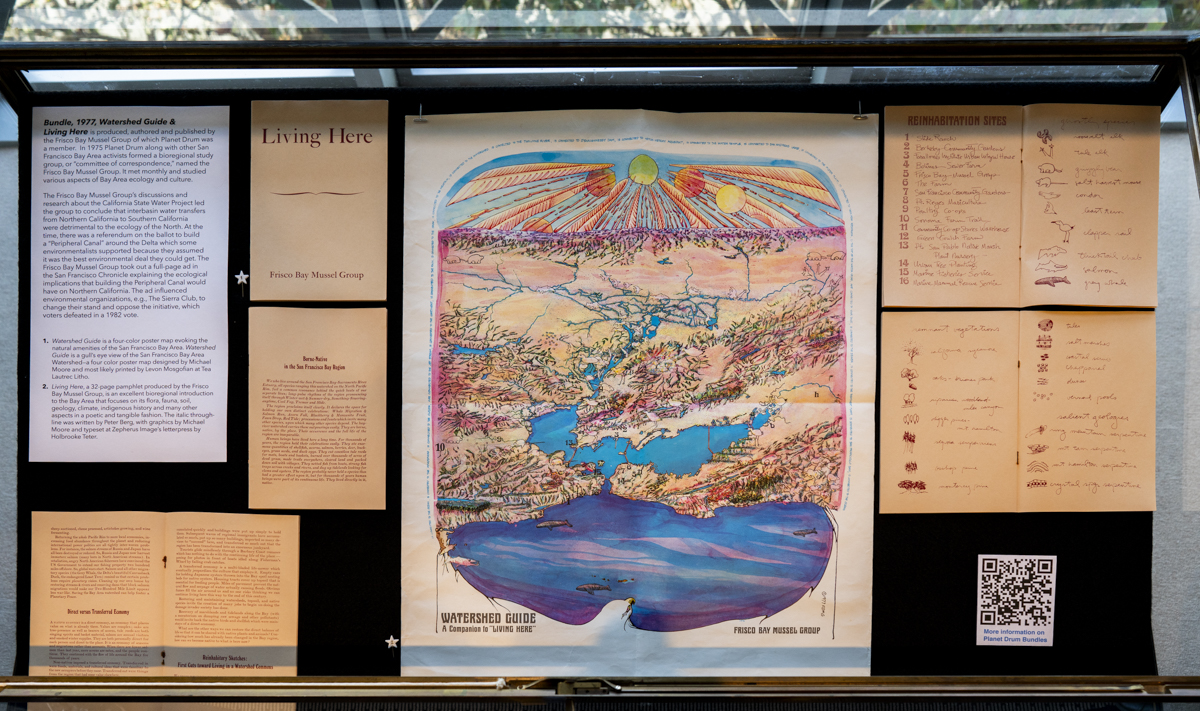
Watershed Guide & Living Here
Produced, authored & published by the Frisco Bay Mussel Group of which Planet Drum was a member.
- Watershed Guide and Living Here, A four-color poster map evoking the natural amenities of the San Francisco Bay Area Watershed with a pamphlet. The 32 page 5.5”x8.25”pamphlet, Living Here, is an excellent bioregional introduction to the Bay Area that focuses on its flora, fauna, soil, geology, climate, indigenous history, and many other aspects in a poetic and tangible fashion. The italic through-line was written by Peter Berg, graphics by Michael Moore. Living Here was typeset at Zepherus Image’s letterpress by Holbrooke Teter and then printed. The Watershed Guide, is a gull’s eye view of the San Francisco Bay Area watershed—a 19”x22” four color poster map designed by Michael Moore, probably printed by Levon Mosgofian at Tea Lautrec Litho.
- [Note for historians: The Green City Program Book was listed as Bundle #5 at the Planet Drum/Green City show at Canessa Gallery in the mid 90s.]
Bundle #6, 1979
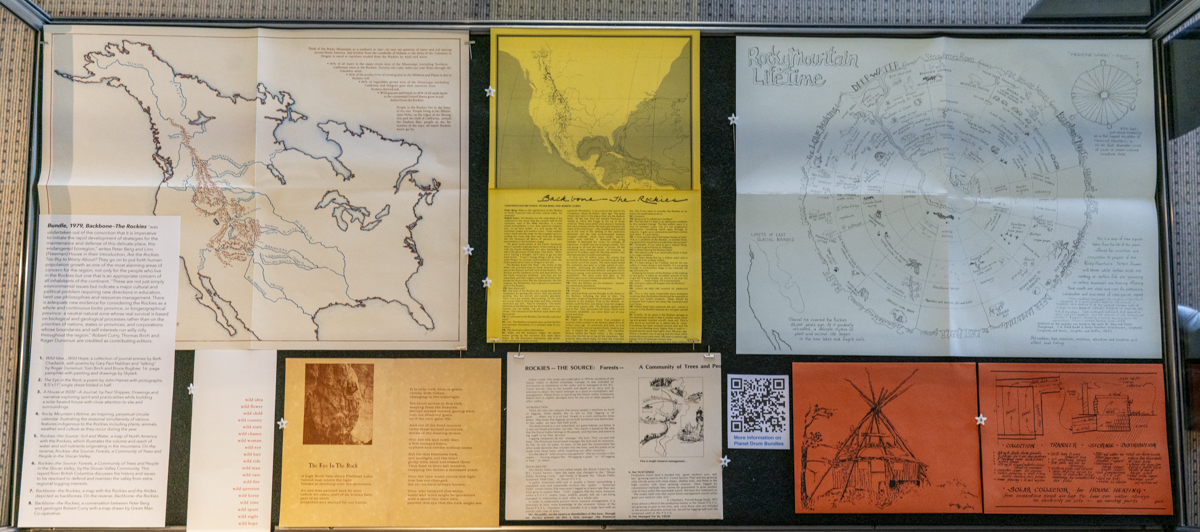
Backbone—The Rockies
- Envelope: white 9”x12” printed with red ink with graphic of a tree growing out of a skeleton in the ground with shaman drumming under the tree. The text is Backbone—The Rockies plus table of contents. (Available for purchase within the Shop).
- Introductory sheet—Are the Rockies Too Big to Worry About? A sensate introduction to these vast mountains, their culture and politics as the bedrock & wellspring for the continent by Peter Berg and Linn (Freeman) House. Includes a table of contents for the bundle. Robert Curry, Thomas Birch and Roger Dunsmuir are credited as contributing editors. (Available for purchase within the Shop). On the reverse is
- a description of Planet Drum as an “explorers guide for planet people” non-profit publishing newsletters, books and bundles. It includes this review by Books West, “ One of the most imaginative publications going is not a single publication, but bundles of them issued together as Planet Drum. Consisting of articles, maps, graphics, posters and poetry…Planet Drum is concerned with the conscious process of reclaiming one’s regional home (and the planet as a whole) from the ravages of inappropriate technology. It is decentralist, mutually respectful, ecologically tuned.” 11”x17 ½”
- Wild Idea…Wild Hope, A collection of: journal entries by Beth Chadwick, poems by Gary Paul Nabhan, and “talking” by Roger Dunsmuir, Tom Birch and Bruce Bugbee. 16 page 4”x9.5” pamphlet with painting & drawings by Skylark. (Available for purchase within the Shop).
- The Eye in the Rock, a poem by John Haines with pictographs. 11”x8.5” single sheet folded in half.
- A House at 8000’—A Journal by Paul Shippee. Drawings and narrative explore spirit and practicalities while building a solar heated house with attention to site and surroundings. Folded 9.5”x23” sheet. (Available for purchase within the Shop).
- Rocky Mountain Lifetime, An inspiring perpetual circular calendar illustrating the seasonal simultaneity of various features indigenous to the Rockies including plants, animals, weather, culture, etc. as they occur during the year. 22”x17”
- Rockies—the Source: Soil and Water, A map of North America with the Rockies, that illustrates the volume and reach of water & soil nutrients originating in the mountains. (Available for purchase within the Shop). On the reverse
- Rockies—the Source: Forests, A Community of Trees and People in the Slocan Valley, by the Slocan Valley Community. This report from British Columbia discusses the history and issues to be resolved to defend and maintain the valley from extra-regional logging interests. 17”x22”. (Available for purchase within the Shop).
- Backbone—the Rockies, A map with the Rockies and the Andes depicted as backbones. (Available for purchase within the Shop). On the reverse
- Backbone—the Rockies, a conversation between Peter Berg and geologist Robert Curry with a map drawn by Green Man Co-operative. 11”x17”. (Available for purchase within the Shop).
Bundle #7, 1980
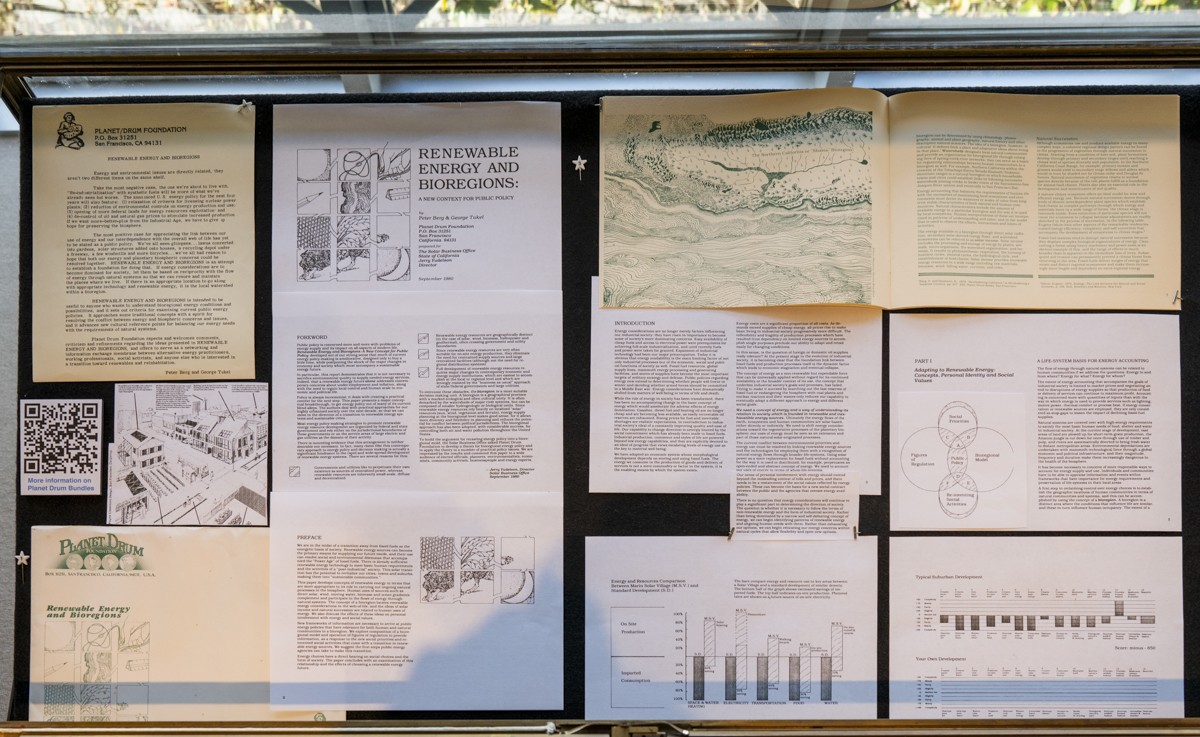
Renewable Energy & Bioregions: A new Context for Public Policy
- Envelope: white 9″x12″ printed with pale green ink with a graphic by Nancy Eckel and the text Renewable Energy and Bioregions and a shaman in the lower right corner.
- Introductory sheet by the authors observes that energy and environment issues are directly related, and that appropriate technology and renewable energy should be based on the appropriate location which is the watershed in bioregions. “It approaches some traditional concepts with a spirit for resolving the conflict between energy and biospheric concerns and issues, and it advances new cultural reference points for balancing our energy needs with the requirements of natural systems.” Comments, criticism and refinements to the ideas are welcomed. 8.5”x11”
- Renewable Energy and Bioregions: A New Context for Public Policy is a 26 page booklet written by Peter Berg and George Tukel Graphics & design by Nancy Eckel. Puts forth the concept that appropriate technology and renewable energy should be based in bioregions on the “solar income” of local watersheds. Prepared for the Solar Business Office of the State of California. Jerry Yudelson, Director of the Solar Business Office contributed the FOREWARD and an Appendix, “Energy Policy Implications,” to the booklet. 26 pages 11”x8.5” booklet.
Bundle #8, 1982

Eco-Decentralist Design
Typeset and printed by Queens College of the City University of New York, Flushing, New York. Published by Planet Drum Foundation (3 booklets)
- Envelope: white 9.5”x9.5” printed with black ink with the graphic of an apple tree growing out of city by Gary Allen. The text is Eco-Decentralist Design with new customs, watershed and energy planning, sustainable communities stacked below the title. (Available for purchase within the Shop).
- Introductory Sheet for the Eco-Decentralist Design bundle. An introduction—“There is a way to conceive of energy production and use, and community development, so that we don’t ultimately destroy the places where we live.” and summary of the three booklets. On the reverse is information about the Planet Drum Foundation and a listing of some of its publications. 8.5”x11”. (Available for purchase within the Shop).
- Figures of Regulation, Guides for Re-Balancing Society with the Biosphere by Peter Berg. Design by George Tukel, Diane Ghisone, Gary Allen, Erich Blohm and Illustrations by Gary Allen. A discussion of social values in the context of bioregionalism. “The ways we live in places must acknowledge the features of local natural systems. Figures of Regulation can help create this bond and provide an ethical basis for community activities based on new customs rather than laws.” 15 pages 8.5”x8.5” booklet.
- Toward a Bioregional Model: Clearing Ground for Watershed Planning “A Map Is Not A Blueprint/Support For Adaptive Tactics/Planning For Necessity And Flexibility” by George Tukel. Design by Diane Ghisonne, Erich Blohm, Gary Allen. Illustrations by Gary Allen. Special thanks to Paul Ryan, Steve Tukel. Developing a model to allow the design of communities and means of provision (food, energy, housing) to resonate with solar income, local watersheds, and the goals of a reinhabitory society. The focus is on community well-being, human services, and the integrity of local ecosystems rather than construction details and political climate. 21 pages 8.5”x8.5” booklet. (Available for purchase within the Shop).
- Reinhabiting Cities and Towns: Designing for Sustainability by John Todd with George Tukel. Graphics & design by Peter Davey with illustrations by Gary Allen & Peter Davey. Special thanks to Nancy Jack Todd and Steve Tukel. It presents a design method to combine the knowledge we have about alternative technology and renewable energy with the biology of specific regions and thoroughly examines practical applications. The goal is to create “beautiful, healing, and inviting” places to live by fusing nature and culture. 64 pages 8.5”x8.5” booklet.
Bundle #9, 1985
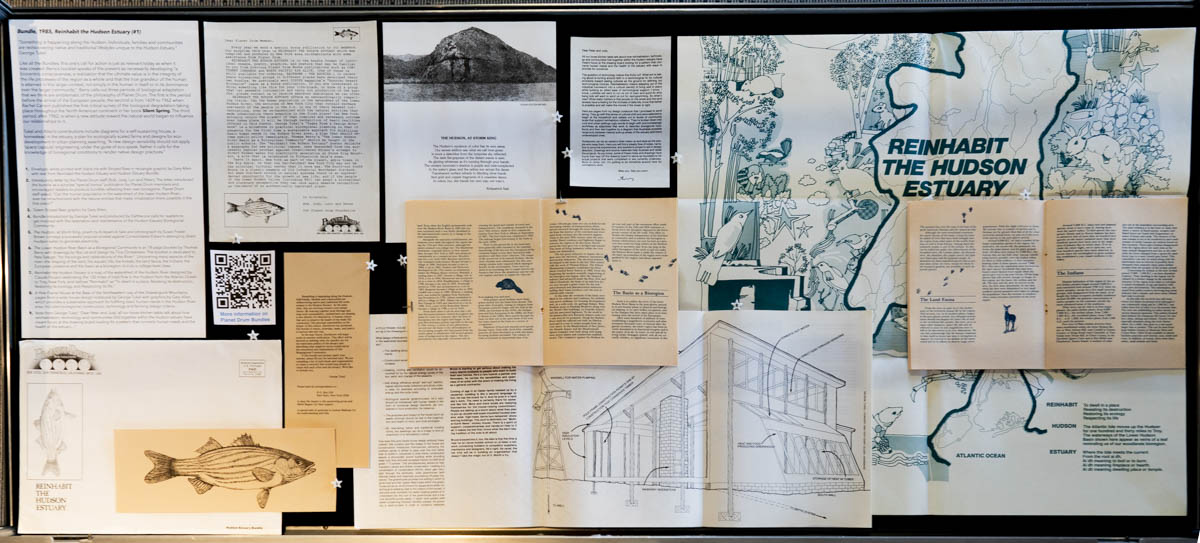
Reinhabit the Hudson Estuary 1
- Envelope: white 10”x13” printed with black ink with Striped Bass in rectangle graphic by Gary Allen with text Reinhabit the Hudson Estuary and Hudson Estuary Bundle. (Available for purchase within the Shop).
- Introductory letter by the Planet Drum Staff (Bob, Judy, Lori and Peter) The letter provided an overview of the bundle’s articles and introduced the bundle as a surprise “special bonus” publication for Planet Drum Members. It also encouraged readers to produce bundles reflecting their own bioregions. Planet Drum Staff asked, “Can the human population in the watershed of the lower Hudson River…ever be reharmonized with the natural entities that made inhabitation there possible in the first place? Can New York actually rejoin the planet? If that inspired and necessary outcome ever takes place it will be through recognition of basic realities offered in this bundle. …Taste it again, New York as part of the planet, apple trees in the Big Apple. Is that too far-feched?”
- Totem Striped Bass graphic by Gary Allen on the front. On the reverse, Bundle introduction by George Tukel notes that the bundle was produced by Earthscore and George Tukel and includes a call for readers to get involved with the restoration and maintenance of the Hudson Estuary Bioregional Community. 4.5”x11”
- The Hudson, at Storm King, a poem by Kirkpatrick Sale with photograph by Susan Foster Brown. Storm King is the site of a successful popular protest against Consolidated Edison’s attempt to divert Hudson water to generate electricity. 8.5”x11”
- The Lower Hudson River Basin As a Bioregional Community by Thomas Berry with drawings by Ilka List, design by Tina Christensen. Dedication: “ To Pete Seeger: For his songs and celebrations of the River,” This essay uncovers many aspects of the river—the shaping of the land, the aquatic life, the forests, the land fauna, the Indians, the European presence, and the basin as a bioregion—truly a college level class. And then speaks of the present as necessarily developing “a biocentric consciousness, a realization that the ultimate value is in the integrity of the life processes of the region as a whole and that the true grandeur of the human is attained in this larger context, not simply in the human in itself or in its dominance over the larger community.” 18 page 7”x8.5” booklet.
- Reinhabit the Hudson Estuary is a map of the watershed of the Hudson River designed by Claude Pousot. It celebrates the 130 miles of tidal flow in the Hudson from the Atlantic Ocean to Troy, New York and delimits an estuarial geography for new political issues. 25”x32”
- A Pole Frame House at the base of the northeastern leg of the Shawangunk mountains Pages from a solar house design notebook with text and concept by George Tukel, graphics by Gary Allen, that provides a sustainable approach for fulfilling basic human needs in the Hudson River area. Includes bioregional construction, technology, farming design criteria. With a 7.5”x5” note attached that begins, “Dear Peter and Judy, All our loose kitchen table talk about how reinhabitation, technology and communities fold together within the Hudson estuary have meant hours at the drawing board looking for a pattern that connects human needs and the health of the estuary…” Four pages 11”x26” folded. (Available for purchase within the Shop).
Bundle #10, 2004
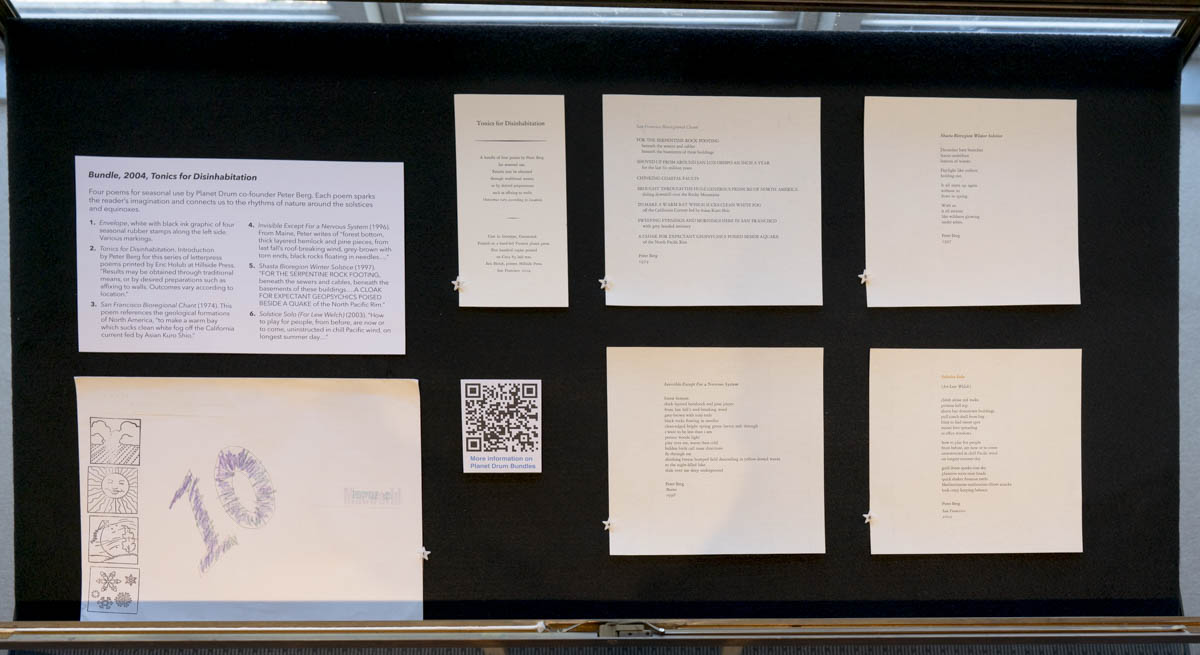
Tonics for Disinhabitation
- Envelope: white 10”x13” with black ink graphic of four seasonal rubber stamps along the left side.
- Tonics for Disinhabitation by Peter Berg. Introduces the poems and their seasonal use. Introduction and poems letterpress printed by Eric Holub at Hillside Press. 8.5”x4.25”
- Four Poems for seasonal use by Peter Berg
- San Francisco Bioregional Chant (1974) title: printed gray 8”x8”
- Invisible Except For a Nervous System (1996) Maine title: printed green 8”x8”
- Shasta Bioregion Winter Solstice (1997) title: printed dark gray 8”x8”
- Solstice Solo (For Lew Welch) (2003) San Francisco title: printed orange 8”x8”
Planet Drum Collaborative Bundles
Bundle #11, 1997?
Bioregional Mapping BookBundle
Produced with the Bioregional Association of the Northern Americas.
(Three books.)
- Boundaries of Home: Mapping for Local Empowerment – 1993 Edited by Doug Aberley
- Giving the Land A Voice: Mapping Our Home Places – 1999 Edited by Sheila Harrington, contributing authors Doug Aberley, Michael Dunn, Briony Penn, Bill Turner, Malcolm Penn, cover art & graphics Briony Penn
- Discovering Your Life-Place: A First Bioregional Workbook – 1994 by Peter Berg
Bundle #12, 1997?
Decision-Making BookBundle
Produced with the Bioregional Association of the Northern Americas.
(Two books.)
- Facilitator’s Guide to Participatory Decision-Making – 1996 by Sam Kaner, with Lenny Lind, Duane Berger, Catherine Toldi and Sarah Fisk
- Introduction To Consensus – 2000 by Bea Briggs.
Bundles Inspired by Planet Drum
Bundle #13, 2016/7?
Edwards Plateau Bundle
Produced by Robert F. Young at the University of TX, Austin during a graduate seminar. Robert taught Bioregional Planning and Sustainable Green Cities classes at Cornell University, the University of Oregon, Eugene and the University of Texas, Austin. He produced a bioregional Bundle for the Edwards Plateau as part of the courses he taught for the Department of Architecture at UT. Rob passed away in January, 2018 quite unexpectedly. For more information about Rob’s incredible work, see his obituary and remembrances.
Bundle #14, 2016, 2018
Reinhabit the Hudson Estuary 2
and
A Bioregional Atlas of Places and Peoples
Seven pieces produced by George Tukel. He continues producing beautiful and essential bioregional Bundles about the Hudson River Estuary. George says, “We have produced a bundle in the tradition of those crafted by Planet Drum. I would like to highlight the Bioregional Atlas we published [a spiral bound 11″x17” book] titled Reinhabit the Hudson Estuary: A Bioregional Atlas of Places and Peoples in 2018. It has original maps and essays that are informative and compelling.”
Both the Atlas and Bundle 2 can be downloaded and printed. You will find them, including printing instructions, at this website: http://www.reinhabitthehudsonestuary.org
Bundle #15, 2018, Fascicolo #1
Produced by Giuseppe Moretti & the Italian Bioregional Path. Giuseppe works with a bioregional study group for the Po River Valley which has produced beautiful Bundles. He also publishes a biannual newsletter, Lato Salvetico (Wild Side), and participates in the yearly gatherings of the SENTIERO BIOREGIONALE (Bioregional Path).
Fascicolo #1

Prodotto dal “Gruppo di Studio per la Bioregione del Bacino Idrografico del Po”
Contiene 17 pezzi, sottoforma di fogli singoli A4 (di diversa grammatura e colore), 2 libretti (21×14 e 21×21), 5 mappe, in A4 e A3. Il tutto contenuto in una cartellina Exacompta 32/23
- Ri-abitare la Bioregione del Bacino Idrografico del Po, introduzione e sommario
- Mappa a colori in A4 del Bacino idrografico del Po, compresi gli affluenti sia alpini che appenninici
- Articolo di Giorgio Nebbia (figura storica dell’ambientalismo italiano, ora non più in vita), intitolato “Far crescere una cultura di bacino idrografico”
- Sempre di Giorgio Nebbia il libretto (8 pagine) “Il bacino del Po: problemi ecologici, economici e amministrativi”
- Articolo di Emanuel Anati “Antiche civiltà: i Camuni”. I Camuni, antico popolo proveniente dal Nord Europa e presente in Valcamonica (provincia di Brescia) dal tardo Paleolitico (8000/9000 anni fa), fino all’arrivo del Romani nel 16 aC
- Serie di articoli di Giampietro Forlani “Vita e Acqua. Bruno Miorali “La pedagogia della lumaca – per una scuola lenta, non-violenta”. Giuseppe Moretti “Bacini fluviali della mente”
- Poesie di Gianni Milano “Verso il Clarea (Affluente della Dora in Valsusa)” e Gary Lawless (Gulf of Maine, New England) “Caro amico Po, tu fiume”
- Foglio fronte/retro con immagini a colori di LandArt, a cura di Chiara Reggiani, Antiche Contrade
- Libretto (38 pagine) di Elisa Viganò “Sentieri, Sappiamo davvero dove viviamo?”. Di tratta della riproduzione su carta di un lavoro descrittivo del luogo dove Elisa vive, originariamente prodotto su stoffa
- Mappa di Bedolina, Val Camonica, Civiltà Camuna, Età del Bronzo 2000 aC – Una antenata delle mappe bioregionali?
- Mappa a colori (foglio A3) della Bioregione Bacino Fluviale del Po, raffigurata sottoforma di foglia di quercia da David LaChapelle, e relativo articolo di Giuseppe Moretti
- Mappa “Corte Gasparola” (su foglio A3 a colori) di Arianna Signorini
- La trama della vita (nel Basso mantovano – su foglio A3 a colori) di Giuseppe Moretti
- Note per un ri-abitare bioregionale tratto dalla newsletter Lato Selvatico
Bundle #1
Produced by the “Study Group for the Bioregion of the Po River Basin”
It contains 17 pieces, in the form of single A4 sheets (of different weight and colour), 2 booklets (21×14 and 21×21), 5 maps, in A4 and A3. All contained in an Exacompta 32/23 folder
- Re-inhabiting the Bioregion of the Po River Basin, introduction and summary
- A4 color map of the Po river basin, including both Alpine and Apennine tributaries
- Article by Giorgio Nebbia (historical figure of Italian environmentalism, now no longer alive), entitled “Growing a river basin culture”
- The booklet (8 pages) “The Po basin: ecological, economic and administrative problems” is also by Giorgio Nebbia
- Article by Emanuel Anati “Ancient civilizations: the Camuni”. The Camuni, an ancient people coming from Northern Europe and present in Valcamonica (province of Brescia/North Italy) from the late Paleolithic (8000/9000 years ago), until the arrival of the Romans in 16 BC
- Series of articles by Giampietro Forlani “Life and Water”. Bruno Miorali “The pedagogy of the snail – for a slow, non-violent school”. Giuseppe Moretti “Wathersheds of the mind”
- Poems by Gianni Milano “Towards the Clarea (Tributary of the Dora in Valsusa)” and Gary Lawless (Gulf of Maine, New England) “Dear friend Po, you river”
- Double-sided sheet with color images by LandArt, edited by Chiara Reggiani, Antiche Contrade * * Booklet (38 pages) by Elisa Viganò “Sentieri, Do we really know where we live?”. It is the reproduction on paper of a descriptive work of the place where Elisa lives, originally produced on fabric
- Map of Bedolina (in A4 sheet), Val Camonica, Camunian Civilisation, Bronze Age 2000 BC – An ancestor of bioregional maps?
- Color map (on A3 sheet) of the Po River Basin Bioregion, depicted in the form of an oak leaf by David LaChapelle, and related article by Giuseppe Moretti
- Map “Corte Gasparola” (on A3 color sheet) by Arianna Signorini
- The web of life (in the Lower Mantua area – on A3 color sheet) by Giuseppe Moretti
- Notes for bioregional re-living taken from the Lato Selvatico newsletter
Bundle #16, 2020, Fascicolo #2,
Fascicolo #2, TEMA: “Testimonianze di resilienza bioregionale”
Prodotto del “Gruppo di studio per la bioregione del bacino idrografico del Po”
- Fascicolo di 44 pagine a colori, su carta canapa e risma field, assemblato e cucito a mano.
- Introduzione e sommario
- Articolo di Oscar Simonetti “Al pascolo”. Allevatore di capre sul Monte Baldo (Verona)
- Articolo di Giampietro Forlani “Viaggio alle sorgenti” del fiume Serio, affluente del fiume Oglio
- Poesie di Arduino Mazzucchelli (poeta contadino) “Albero solitario” “Meraviglie del cielo”
- Intervista a Antonio Tesini di Bruno Miorali “ La cooperativa Cà Magre come soggetto di resilienza territoriale”
- Articoli di Antonio Tesini “Riflessi di palude” e “Molin Novo della Madonna”. Il primo sul ripristino della Palude di Pellegrina a Isola della Scala (VR), il secondo sul ripristino di un mulino ad acqua sul fiume Tartaro, a sud della palude di Pellegrina
- Articolo di Chiara Reggiani “Molin novo della Madonna” parte 2
- Serifrafia a colori di Francesca Martini, soggetto: “Salix Alba”
- News) “Lo Storione, dopo mezzo secolo ritorna a risalire il Po”, grazie alla costruzione di una scala di risalita per i pesci a Isola Serafini (Piacenza)
- Poesia di Gary Snyder “Isola Boschina” (Ostiglia, Mantova), dopo una sua visita nel 2004
- Articolo di Giuseppe Moretti “A volo raso”. Una storia di resilienza in Pianura Padana
- Portfoglio poetico (12 pagine) di Gianni Milano “L’acqua è il grande respiro della montagna”
Bundle #2, TOPIC: “Testimonies of bioregional resilience”
Produced by the “Study Group for the Bioregion of the Po River Basin”
- Booklet (29×21) of 44 color pages, on hemp and field paper, assembled and sewn by hand.
- Introduction and summary
- Article by Oscar Simonetti “In the pasture”. Goat breeder on Monte Baldo (Verona)
- Article by Giampietro Forlani “Journey to the sources” of the Serio river, a tributary of the Oglio river
- Poems by Arduino Mazzucchelli (peasant poet) “Lonely tree” “Wonders of the sky”
- Interview with Antonio Tesini by Bruno Miorali “The Cà Magre cooperative as a subject of territorial resilience”
- Articles by Antonio Tesini “Marsh reflections” and “Molin Novo della Madonna”. The first on the restoration of the Pellegrina swamp in Isola della Scala (VR), the second on the restoration of a water mill on the Tartaro river, south of the Pellegrina swamp
- Article by Chiara Reggiani “Molin novo della Madonna, part 2”
- Color screenprint by Francesca Martini, subject: “Salix Alba”
- AA.VV “The Sturgeon, after half a century, returns to swim up the Po”, thanks to the construction of a fish ladder at Isola Serafini (Piacenza)
- Poem by Gary Snyder “Woodsy Isle” (Ostiglia, Mantua), after his visit in 2004
- Article by Giuseppe Moretti “A low flight”. A story of resilience in the Po Valley
- Poetic portfolio (12 pages) by Gianni Milano “Water is the great breath of the mountain”
Bundle #17, 2023,
Celebrating 50 Years of Living Here, San Francisco Bay Area
The teen and mentor artists of Artivate researched the legacy of Planet Drum, printed Planet Drum 50th anniversary (recycled) merch at key Planet Drum events, and created their own bundle. When possible, they used recycled or upcycled materials in keeping with the larger aims of the project.
- Eschschalzia Califormica by Alec De La Cruz presents the California State flower and invites you to plant the seed and create your own native garden from the seeds he harvested himself.
- Amaris Medina-Kelley offers “Her House,” a discussion on what we as “house sitters” are doing to Mother Earth. This handprinted linoleum-block print is meant to be folded into a three-dimensional model of a house.
- Amy Berk and Chris Treggiari, Co-Directors of Artivate, collaborated on a reusable handkerchief that addresses the current Israel/Hamas war and its far-reaching trauma. They researched the correct way of writing ‘forgive’ in both Hebrew and Arabic, and included a flower representing peace, hoping to bring some of both to a highly charged world.
- “Salesforce Trailblazer DX vs California Fescue” by Cheryl Meeker utilizes a free piece of swag from a Salesforce conference to examine and contrast the effects in our world of the company behind the latest huge new skyscraper in San Francisco and a small native bunch grass called California Fescue.
- Devon Zeches offers a piece entitled “Mother Nature” showcasing her connection to nature and how that informs her relationships. This piece is comprised of recycled materials found at SCRAP, utilizing the scraps of people’s discarded memories and finding another life for them.
- Esme Charles creates beautiful hand-stamped and hand-printed earth-centric stationary for you to populate with your own message and send out, acknowledging both the original PLANET DRUM-beat and the debt we all have to the earth.
- “Hawaii Burning” by Kim Lee references not only climate change including the wildfire that destroyed part of Hawaii in the last year, but how corporate culture is commodifying and taking advantage of native lands in Hawaii and elsewhere. “Let us not be blinded by this capitalistic society and open our eyes to the not so ‘perfect paradise’ world.“
- Lilah Edelsom presents “California Environmentalists” showcasing that you don’t have to be famous to be an environmentalist and that we all have the capacity to be environmentalists!
- Both a poem and a collage make up Rihiannon Hewett’s contribution. “We are Not One side” and “Built on Both” display the concept that we are not rural or urban. We build the idea that we have to be one or the other, when, in reality we are both.
Bundle #18, 2024, Fascicolo #3
Fascicolo #3, TEMA: “Conoscere la propria bioregione”

2024, Gruppo di Studio per la Bioregione del Bacino idrofafico
Contiene 10 pezzi, sottoforma di fogli singoli A4 (di diversa forma, grammatura e colore); 1 libretto (21×14); 3 mappe, in A4 e A3; 1 dispensa (29×21). Il tutto contenuto in una cartellina Starline (24/34).
- Dispensa “Conoscere la propria bioregione”, pagine 26, cucita a mano. Contiene uno studio sull’ittiofauna di Giovanni Luca Bisogni “Ittiofauna del fiume Po”; “Note conoscitive sui maggiori affluenti del Po” di AA.VV; “Le antiche foreste padane” di Vito Fumagalli (dal Medioevo ai giorni nostri); “Elementi di ecologia fluviale” di Giuseppe Sansoni (in difesa dei fiumi e dai fiumi).
- Poesie di Loris Canalia: “Ritorno alla gioia”, “Trattori pesanti”,
- Arduino Mazzucchelli “Primavera”, Estate”, “Autunno”, “Inverno”;
- Monica Sorti “Il fiume Po”;
- Gianni Milano “Le mie terre”;
- (Note a): Conoscere la propria bioregione di Odilio Madini (sulle organizzazioni di volontariato)
- Camminare i meandri del fiume” di Giuseppe Moretti (una camminata sulla neve seguendo le tracce di una Faina)
- Libretto artistico (8 pagine) “Nulla più del fiume scorre/Cattedrali vegetali” di Giulia Flavia Baczynski (vegetazione e arte, il caso del Sicyos angulatus, una pianta rampicante alloctona)
- Mappa (A3 a colori) “Palude di Pellegrina” di Chiara Reggiani
- Mappa (A4 a colori) Bacino del torrente Masino (affluente dell’Adda) di Emilio Ciapponi
- Mappa (artistica in A4 a colori) Bacino idrografico del fiume Po di Francesca Martini
Bundle #3, Topic: “Knowing your bioregion”
Produced by the “Study Group for the Bioregion of the Po River Basin”
It contains 10 pieces, in the form of single A4 sheets (of different shape, weight and colour); 2 booklets (21×14) and (29×21); 3 maps, in A4 and A3. All contained in a Starline folder (24/34).
- Booklet “Knowing your bioregion”, 26 pages, hand-sewed.
- It contains a study on ichthyofauna by Giovanni Luca Bisogni “Ichthyofauna of the Po river”;
- “Informative notes on the major tributaries of the Po” by Various authors;
- “The ancient Po Valley forests” by Vito Fumagalli (from the Middle Ages to the present day);
- “Elements of river ecology” by Giuseppe Sansoni (in defense of rivers and by rivers).
- Poems by Loris Canalia: “Return to joy”, “Heavy tractors”,
- Arduino Mazzucchelli “Spring”, Summer”, “Autumn”, “Winter”;
- Monica Sorti “The Po River”;
- Gianni Milano “My lands”;
- “Knowing your bioregion” by Odilio Madini (notes on volunteers organisations)
- “Walking the river meanders” by Giuseppe Moretti (a walk in the snow following the traces of a marten)
- Artistic booklet (8 pages) “Nothing more than the river flows/Vegetable cathedrals” by Giulia Flavia Baczynski (vegetation and art, the case of Sicyos angulatus, a non-native and invasive vine plant)
- Map (A3 colour) “Palude di Pellegrina” by Chiara Reggiani
- Map (A4 colour) “Masino torrent basin (tributary of the Adda river)” by Emilio Ciapponi
- Artistic map (in A4 colour) “Po river watershed” by Francesca Martini
